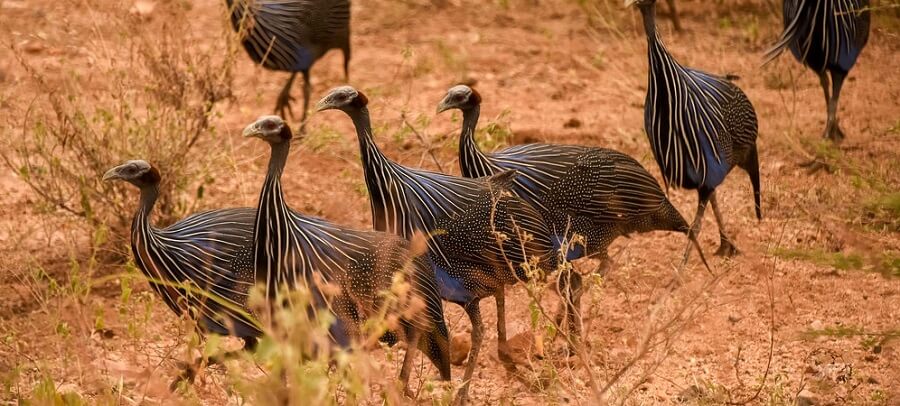Guinea Fowl, proof that the Lord has a sense of humor! Are you considering raising those funny-looking birds? Guinea fowl are very different to raise than chickens and they bring a new set of rewards and challenges. This article covers everything you need to know about owning guinea fowl.
There are seven species of guinea fowl. They are related to turkeys but have a flavor more like a pheasant. Guinea fowl are considered a delicacy in restaurants. Native to Africa, they have retained their wildness and never submitted to domestication. As a result, guineas are very healthy birds that don’t get sick easily.
If you are planning on raising them, there are a few things you’ll need to do.
1. Understand Differences Between Guinea Fowl And Other Birds
It might be easy to assume that raising guinea fowl is similar to raising chickens, turkeys or ducks. After all, they all eat bugs, were once wild birds, and lay eggs. But nothing is farther from the truth. In reality, guinea fowl are much different than their cousins.
Despite years of domestication, guinea fowls have never truly been domesticated. They are still as wild in captivity as they are in their native habitat. Taming a guinea fowl is much like befriending a forest deer. They might let you feed them, but they won’t give you any loyalty for it.
Guinea fowl are similar to chickens or ducks in that they eat bugs, rodents, and even snakes. But, they do a much better job of it than chickens or ducks. While other poultry birds make a reduction in the bug population, guinea fowl will completely eradicate it. They consume massive qualities of bugs. Guineas eat bugs that other birds leave alone.
Yet.
They don’t eat your garden or your plants. They are the ideal ally or your garden.
The give a new meaning to the word flock. While chickens flock and ducks line up, guinea fowl march in a line to conquer new territory. These little soldiers systematically consume all living things they encounter across your yard and garden. That’s what makes them so effective.
Guinea fowl also fly. While chickens flap and leap, guineas can fly high and they can fly far. It is not uncommon for guinea fowl to fly over a house or across the block. Some guinea fly away and never return.
And clipping their wings won’t help much because while it can keep them from flying much, it also makes them very vulnerable to predators. Because of their great flying abilities, guineas can hold their own against a neighborhood dog, cat, snake, or another predator. But, when their flight is limited, they become the prey.
- Guinea Fowl Stay Wild
- They Fly Really Good And Far
- Eat All The Bugs

2. Prepare Guinea Fowl Coop
Guinea fowl don’t coop that well. They can fly very high so it’s nearly impossible to build a coop with walls high enough to keep them in. Guinea fowl are either cooped or free-range. If they are cooped, they will not help with the bugs because they can’t access them. If they are allowed to free-range, they are likely to leave.
Most guinea fowl owners offer a coop to their guinea fowl but don’t keep them in it. If you desire to keep your guinea fowl cooped, then you will need to prepare it with netting over the top of the coop.
This is the only way to keep the guinea fowl from flying over the fence. Guineas need about 30 square feet per dozen birds or about 2-3 square feet per bird.
A guinea hutch is really more for protection for your guineas than something they need. Guineas don’t need nesting boxes and won’t use them.
Guinea fowl that return to the coop at night only do so because they are semi-trained to. Even then guinea fowl will often nest in other areas for the night.
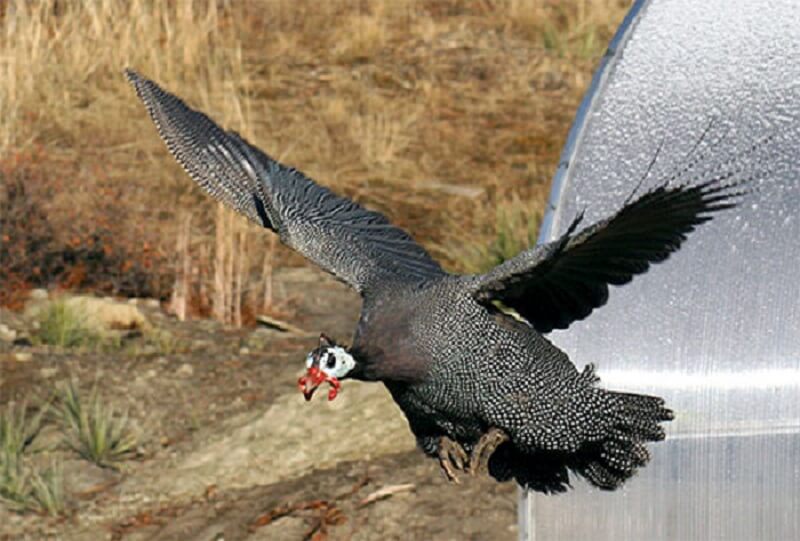
3. Raise Guinea Fowl Keets
Guinea fowl hatchlings are called keets. They are often sold at only 1 day hatched. The best way to semi train and domesticate guinea fowl is to raise keets and to handle them often. Buy the youngest keets available.
Some places will ship day-old keets for you to raise. Usually, the place that keets are raised determines where adult guineas call home the rest of their lives. The only way to semi-tame guineas is to raise keets. Handle them daily and let them get to know you.
Keets are small and can escape through ½ inch mesh. They need to be kept dry and warm for the first few weeks.
Guinea chicks can be sexed at 8 weeks old. Each species has a different coloring between males and females. However, the best way to sex guinea is by their sound.
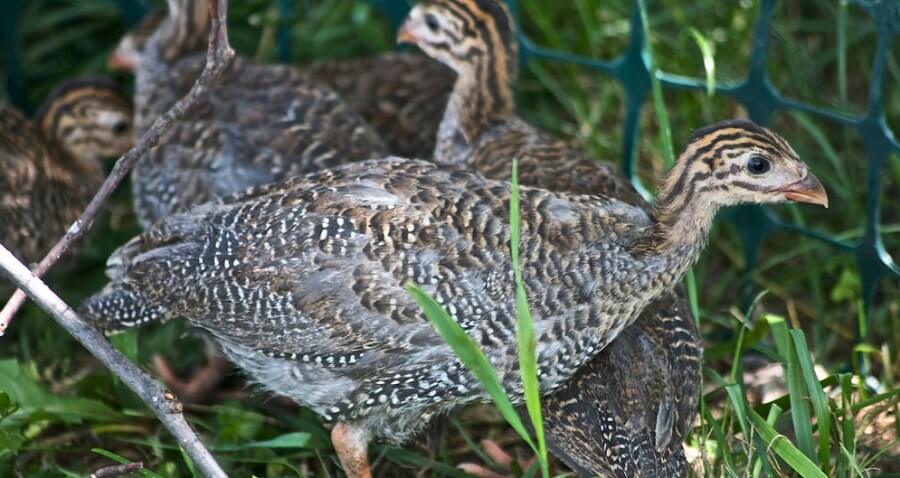
Guinea Fowl Keets
4. Provide A Warm Brooder For The Babies
Guinea hatchlings need a brooder. It should not be a caged option as keets can escape quite easily. Instead, consider a cardboard box or a Rubbermaid box that provides solid walls. Chicks need enough space that they don’t trample each other.
Line the brooder with shredded newspaper for the first few days. Bedding can be changed after a few days to wood chips. Do not use sawdust because keets will try to eat it and will get sick from the sawdust.
Guinea brooders need to be set at 95 degrees F (35 degrees Celsius) the first three days. Every three days, drop the temperature by 5 degrees. You can do this by raising the heat lamp a little higher.
If the chicks are cold, they will huddle right under the heat lamp and if they are too warm, they will crowd in the corner farthest from the heat lamp.
Guinea babies must be kept warm and dry. They must be fed higher protein than adult guineas and their water should be lukewarm. In the wild, guinea keets only have about a 20% survival rate.
At 3 weeks, keets should have at least 1 square foot per keet in their brooder. At one month, their first set of feathers will start growing.
You can know if your baby guinea are unhappy by the sound they make. Keets sound like unhappy chirping crickets. They are muquieteriet when they are happy.

5. Feed Guinea Fowl Enough Protein To Keep Them Healthy
Guineas should not be fed chicken food. Instead, they should be fed a wild game or turkey food. If you have to feed an adult guinea chicken food for a few days, then do not feed it medicated feed and add protein into the food.
Guinea keets should be fed a 28% turkey starter. At a minimum, babies should be fed at least 24% or higher protein. During weeks 5-8, you can drop their protein mix to 18%-20% protein. Laying hens should be fed a 16% protein mix.
This is my recommended Guinea Fowl feed on Amazon.
| Guinea Fowl Keets Weeks 1-4 | 24%-28% Protein Mix |
| Guinea Fowl Keets Weeks 5-8 | 18%-20% Protein Mix |
| Guinea Fowl Laying Hens:
Switch hens to the laying feed in February. |
16% Protein Mix |
Wild bird and turkey feed can be ordered on Amazon. But, if you are unable to find game bird feed, you can use non-medicated chicken food with added protein. You can also feed keets a protein mix.
As babies, you can feed your keets mashed hard-boiled eggs mixed with cottage cheese and oatmeal. (Chicken feed not necessary)
When keets are 5 weeks old, you can switch to a mixture of cracked corn and whole wheat. Add mixed-grass clippings, lettuce, and other greens.
Never feed keets moldy food.
Guinea fowl can be trained by teaching them to come for treats. Appropriate treats include millet, sunflower seeds, greens, and bugs.
Guinea will supply most of their own feeding needs by foraging for bugs and other small animals. Your food supply is mostly a supplemental to their own foraging. Even in the winter guinea fowl can forage through the snow.
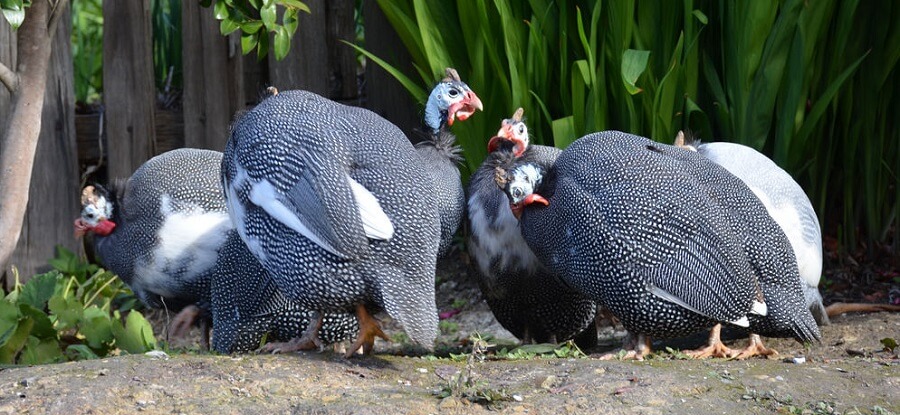
6. Water Guinea Fowl And Keep Them From Drowning
Guinea fowl chicks will easily drown themselves. Feed chicks through drown-proof water bowls. Either place a screen over the top of the watering dish or use a chicken waterer that keeps a shallow depth.
You can also place marbles in the water to keep it from getting too deep. Chicks will be able to drink, but not drown.
Guinea must be kept with constant water. They drink a lot of water. Chicks should be given lukewarm water to keep them from getting chilled.
7. Semi-Train Adult Guinea Fowl To Return To The Coop
Training guinea is unlike training chickens or ducks. They always maintain a certain amount of wildness. You will have better luck training keets to return to the coop at night and to come for treats.
But if you purchase adult guinea fowl and need to train them to come back at night there are a few things you must do.
First, keep adult guinea fowl caged in their new home at least 6 weeks. This gives them time to adjust to the new area. Adult guinea that isn’t caged long enough for them to adjust will fly away.
They usually associate home with the location that they lived as keets.
Second, let only a single male out of the cage for 3 or 4 days.
Guinea usually mate in pairs in the wild. However, in captivity ne cock to 4 or 5 hens is a good ratio. They are also very social. Letting the male out increases the chance that he will come back to the coop to be near the other guinea.
After a few days, let out another male guinea. They will likely come back to be near the females. Continue letting out one more guinea every 3 or 4 days until all the guinea come back at night.
This isn’t 100% effective but is the best way to train adult guinea. You can also feed them at the coop so that they learn that treats are offered there.
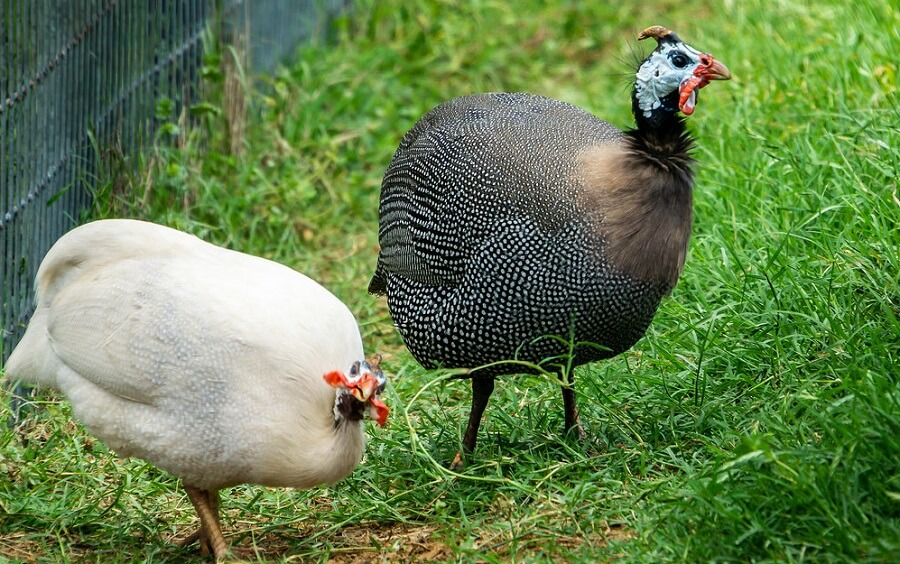
Helmet Guinea Fowl
8. Learn To Appreciate Guinea Chatter
Guinea fowl are noisy. They maintain a constant chatter while they move about. They are much louder and constant than chickens and even rival roosters in the noise they make.
Hens make a sound that some say sounds like “come-back come back” or a “good-luck, good-luck.” Cocks make a trilling sound a lot like “chi-chi-chi chrrr!” Their sound is the easiest way to sex a guinea.
Guinea have been called the watchdogs of the yard. They will screech and chatter when something invades their space. This can be anything from a fox or snake to a human visitor. They sound the alarm when something concerns them.
This is often a bonus for farmers. Guinea are used as watch animals to protect chickens, ducks, and other animals. They can roam with goats and sheep.
They even alert their owners if something comes around at night.
But, they also sound a false alarm. They may be alarmed at cars driving by, sudden noises, or bad weather. They will be loud.

9. Enjoy Their Odd Way Of Nesting
Guinea fowl will bed down for the night anywhere. They may decide to bed at the top of your trees- near a hawk nest, or on your rooftop. They have a mind of their own. They often nest high up where predators can pick them off.
If you have guinea fowl, you will lose some of them to predators and it will be difficult to eliminate that. They are so independent that you simply won’t be able to force them in at night and sometimes that will mean death for them.
Get used to the odd places that they bed down. They also love to hide their eggs. They may lay their eggs at your neighbor’s house, in the woods, or across the river.
You may think that you have lost guinea to predators to have them come back a month later with little ones in tow.
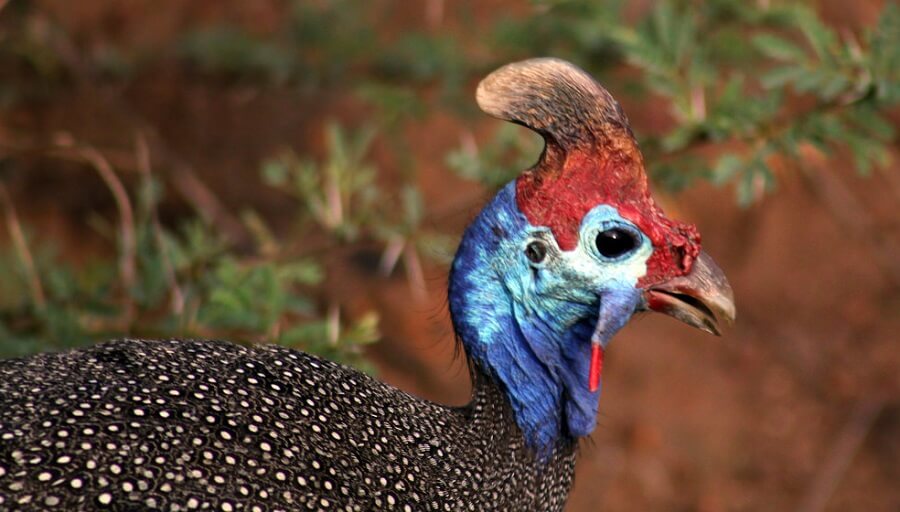
10. Understand The Pecking Order Of Guinea Fowls And Roosters
Guinea fowl are barnyard bullies. Many chicken owners report that when guinea fowl are raised beside chicken, that it calms the guinea down. They are more likely to gather to the coop at night and more likely to stay close.
But, they will rule the roost. The rooster will find himself kicked off the top of the pecking order. Guinea fowl are bullies. They will pick on your chicken and steal their food. Guinea can be raised alongside chickens, but it must start from the time they are little.
Guinea cocks are very domineering during mating season. They have also been known to mate with chickens, but the offspring will be sterile.
You will need to separate your roosters from the guinea cocks during the spring. The best way is to pull your chickens out so that your guinea continues to return to the coop at night.
Guinea don’t respond well to territorial changes.
11. Harvest Guinea Fowl Eggs, If You Can Find Them
Guinea fowl love to hide their eggs. Or, they can just as easily lay them anywhere. When they decide to nest, they will lay their eggs all in the same place. That means that if you are looking for one hiding spot with as many eggs as you have guinea hens.
Guinea hens lay eggs only during laying season. Hens must be a year old. The laying season lasts from March to May and a single hen usually lays around 100 eggs during that time. Most hens will lay for about 5 years even though guineas can live up to 15 years.
Guineas usually lay their eggs in the late morning or early afternoon.
Guinea hens are good setters. They will often take turns sitting on the whole flock’s worth of eggs.
You may encounter a hormonal hen sitting on the eggs or just as easily find that the mothers have forgotten about the eggs and hidden them, then abandoned the eggs. Guinea seems to find enjoyment in finding the most obscure places to lay their eggs. They love to lay in trees, long grass, among weeds or other hidden areas.
If you wish to harvest eggs from a nest but want to encourage the hens to keep laying there, then take all but 4 or 5 eggs. Mark the eggs so you can tell them apart in the future.
Leaving the eggs in the nest encourages the hens to continue to lay there. If all the eggs are taken out, the hens will usually find a new place to lay their eggs.
Guinea eggs are smaller than chicken eggs and have a thicker shell. They are speckled and higher in protein.
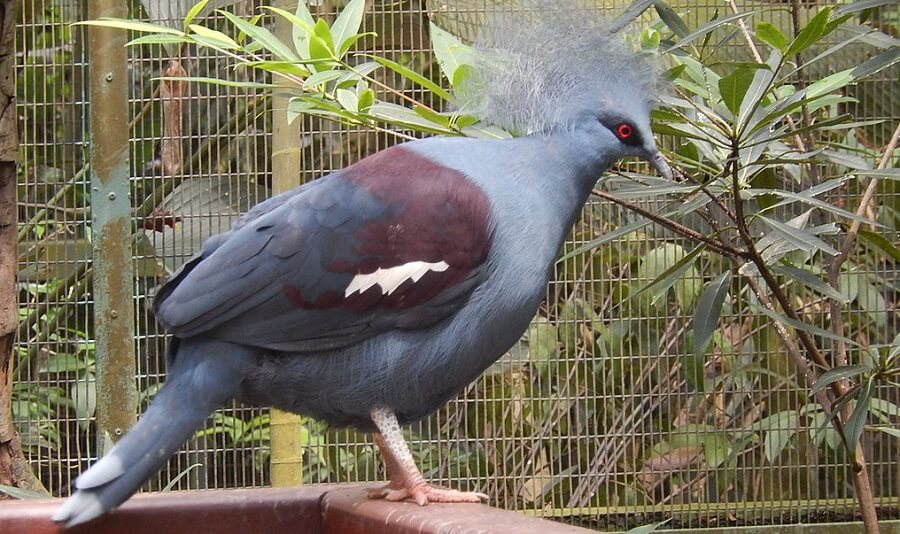
12. Save Babies From Careless Guinea Mothers
Guinea fowl hens are usually at least decent brooders, but they are horrible mothers. The keets are super fragile, but the mothers are completely clueless.
When the eggs hatch, mothers will march the young through water, wind, snow and in front of predators. This is when they show their greatest stupidity.
The mothers are not protective of the babies and often expose them to extreme situations that causes the deaths of many babies.
In the wild, only 20% of guinea keets survive the first 4 weeks.
If you want to raise more guinea fowls, you will need to step in and rescue the babies. Wait a day or two until the mother appears to lose interest in the babies. Then collect the keets and bring them to the brooder so you can keep them warm and dry.
You can save the majority of the babies this way.
13. Incubate Eggs To Grow The Flock
Although guinea fowl hens can be good brooders, they are also forgetful brooders. It’s important to incubate the eggs if hens abandon the nest or aren’t brooding well. If you have a cock to 4 or 5 females, your guinea eggs will have nearly a 100% fertility rate. That means all your eggs are good to incubate.
Another option is to use a broody hen. A single average-sized batan 12-15 guinea eggs. Larger hens can brood as many as 20-25 guinea eggs.
If you choose to incubate the eggs, keep the incubator at 99.5 degrees F. The humidity level should stay between 35%-45% humidity. Guinea eggs take between 26 and 28 days to hatch.
14. Enjoy The Benefits Of Guinea Fowl
Guinea fowl are great at protecting your area from ticks and snakes. They love tics, a bug that chickens will eat, but also carry. Guinea can completely wipe out an insect population in the area.
Plus, they effectively ward off many types of predators. They are noise, unified, and make a terrifying group to confront. Guineas have been known to corner dogs, cats, and snakes.
Many predators simply stop coming around when guineas have claimed an area.
This includes snakes. Guineas are very combative against copperheads and rattlesnakes. They easily kill and eat the dreaded snakes. Other snakes simply choose to avoid areas where guineas occupy.
Guineas can keep squash bugs and other garden pests out of the garden. The do love freshly tilled dirt so it’s a good idea to keep them out of the garden (if you can) until after your seedlings have sprouted and grown a bit.
But, they usually don’t bother the plants. They will eat bugs off the plants and keep your garden intact, although there may be a few exceptions.
15. Teach Your Neighbors To Love Guinea Also
As a guinea fowl owner, you will need to help your neighbors love your guinea. Guinea fowl have no boundaries. They do not care if they are crossing into other’s property, flying over a fence, or holding up traffic.
They will go anywhere and everywhere they want to go.
This means that your neighbors will hear them and see them. They will hopefully learn to appreciate the effectiveness that the guineas keep bugs away from their property also.
Patience will be required as you will need to collect your guinea from down the street only to have them take flight again.

Vulture Guinea Fowl
Guinea Fowl Health
Guineas fowl have retained their strong immunity from the wild. They rarely get sick or infected with parasites. There aren’t approved medicines for guineas either. They are hardy and strong.
Even if an illness infects your chickens, your guineas will stay strong.
The main weakness that guineas have is in their young. Once they make it to adulthood, they are strong and healthy.
Species Of Guinea Fowl
There are 7-10 species of guinea fowl, depending on the classification used. Guinea fowl are in the family Phasianidae, the order Galliformes. The species are:
- Vulturine Guinea Fowl (Acryllium vulturinum) East and Central Africa
- Helmeted Guinea Fowl (Numida meleagris) Sub-Suharan Africa. Usually, the species domesticated.
- White Breasted Guinea Fowl (Agelastes meleagrides)
- Black Guinea Fowl (Agelastes niger)
- Plumed Guinea Fowl (Guttera plumifera)
- Crested Guinea Fowl (Guttera pucherani) This guinea fowl has three subspecies
- * I could not find information on the 7th specie of guinea fowl

